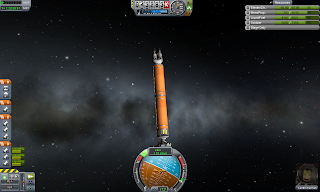Receptets alla ingredienser mäts i volym istället för vikt. Jag har tagit receptet från "The Breadbaker's Apprentice" av Peter Reinhart, en absolut suverän bok, och gjort några mindre anpassningar.
Degen förbereds i två steg, och sedan ska bagelserna formas, jäsa, kokas i vatten, och till sist bakas i ugnen. Många steg och mycket arbete, men det är värt besväret!
1. "sponge"
1 tsk torrjäst
1 liter vetemjöl special
650 ml ljummet vatten
Ta fram en riktigt stor skål. Blanda mjöl och jäst, och blanda in vattnet. Blanda inte för mycket, bara tills det har blivit en ganska jämn smet.Täck skålen med plast och låt stå ett par timmar i rumstemperatur. Blandningen kommer bli väldigt bubblig, därför heter det "sponge".
Den är redo för nästa steg om den är circa dubbelt så stor, och kollapsar när man skakar skålen eller dunkar den mot bänken.
2. "dough"
0.5 tsk torrjäst
8.5 - 9 dl vetemjöl special, eventuellt blandat till hälften med finmalet fullkornsvetemjöl.
3 tsk salt
1.5 msk brödsirap (eller mörk sirap)
eventuellt socker, kanel, och russin. Eller annars stekt lök eller chilipeppar eller pressad vitlök, till exempel.
Blanda in jästen i samma skål. Tillsätt det mesta av mjölet, allt salt, och sirapen. Blanda ihop tills alltsammans bildar en stor klump, och lägg till resten av mjölet litet i taget för att få fram en stadig deg.Lägg ut degen på bordet för att knåda. Den ska knådas i minst 10 minuter. Degen ska vara riktigt stadig - stadigare än deg till franskt bröd, men fortfarande smidig och len. Det får alltså inte finnas kvar något torrt mjöl, och man ska kunna dra i degen så att den formar en tunn hinna utan att degen rivs i bitar. Jag får det aldrig riktigt så fint, men för bagels är det bäst att ha lite för torr deg än för våt. En bra bagel är tuggig!
Om du vill ha någonting gott i bageln är det lämpligt att tillsätta detta under knådningen, när degen nästan är färdig. Jag delade degen i två bitar, blandade socker med kanel och russin, och vek in blandningen i den ena hälften för att få söta russin-bagels. Den andra hälften var utan fyllning.
Nu delar man degen i 16 lika bitar på ungefär 125-150 gram var. Det blir stora bagels, men stora bagels är goda och dessutom lättare att hantera än små bagels.
Rulla bitarna som om du gjorde bullar, lägg bullarna på en plåt under en våt handduk, och låt stå en halvtimme. Den tiden behövs för att låta glutenet slappna av och forma om, och för att jäsa lite.
3. Bagels!
Forma bagels genom att trycka ett hål genom mitten på bullarna med pekfinger och tumme, och sedan töja hålet så det blir lagom stort och det börjar likna en bagel. Hålet ska vara betydligt större än det önskade slutresultatet; hålet krymper med jäsning, kokning, och bakning. Jag tycker själv att en bagel med litet hål är godare, eftersom det är lättare att stapla upp pålägg utat att det trillar genom hålet. Även så brukar jag forma bagels där hålets diameter är 1.5 gånger större än diametern av degringens tvärsnitt.Lägg bagelserna på en infettad bakplåt, och spreja eller pensla med olja så de inte torkar ut. Lägg plast över, och låt stå i rumstemperatur en halvtimme.
Om de har jäst lite (men märkbart), är de redo att ställas i kylskåpet.
4. Kyl
De ska ligga och mogna i kylskåpet minst 8 timmar, och upp till två dygn.5. Koka
Mycket vatten
1 msk bikarbonat
Något gott att strö på, till exempel en blandning grovt havssalt och frasig lök, eller salt och linfrö, vallmofrö, och sesamfrö kanske.
Ta fram dina bagels från kylen.Ta fram en stor gryta eller kastrull att koka vatten i. Den ska vara så bred som möjligt. Fyll med vatten och koka upp vattnet. När vattnet kokar, häll i en matsked bikarbonat. En stekspade eller slev med hål i kommer att vara nödvändigt för att fiska ut bagels från det kokande vattnet.
Ställ ugnen på 250 grader.
Förbered bakplåtar genom att strö grovt majsmjöl (polenta funkar jättebra) i ett lagom tjockt lager.
När allt är redo, lägg i så många bagels som får plats på ytan av grytan. Grytytan - ett underbart ord. De flyter! Koka en minut på en sida, vänd och koka en minut till. Efter två minuter i total, hämta ut bageln och lägg på bakplåten. Om du vill ha salt topping ska det strös på omedelbart så det klistrar fast. Söta toppings kommer senare.
Man bör först koka alla "normala" bagels innan man kokar bagels med socker och russin - annars blir resten av bagelserna lite halvsöta och ganska oaptitliga. Å andra sidan, om du har vitlök i dina "normala" bagels är det nog bäst att koka söta bagels i nytt vatten, annars får man nog smaka vitlök och kanel med russina... urk!
6. Baka
När en plåt är fylld kan den gå i ugnen. Baka i 250 grader för 5 minuter. Skruva ner värmen till 220 grader och baka 5 minuter till, eller tills du har fått rätt färg.För russin bagels kan man smälta smör och blanda till mer socker och kanel. Pensla nybakade bagels med smöret och strö på eller doppa i sockerblandningen för att få en smarrig skorpa.






































